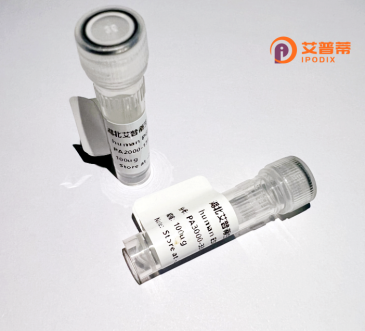
| 纯度 | >90%SDS-PAGE. |
| 种属 | Human |
| 靶点 | OR10G3 |
| Uniprot No | Q8NGC4 |
| 内毒素 | < 0.01EU/μg |
| 表达宿主 | E.coli |
| 表达区间 | 1-313 aa |
| 活性数据 | MERINSTLLTAFILTGIPYPLRLRTLFFVFFFLIYILTQLGNLLILITVWADPRLHARPMYIFLGVLSVIDMSISSIIVPRLMMNFTLGVKPIPFGGCVAQLYFYHFLGSTQCFLYTLMAYDRYLAICQPLRYPVLMTAKLSALLVAGAWMAGSIHGALQAILTFRLPYCGPNQVDYFFCDIPAVLRLACADTTVNELVTFVDIGVVVASCFSLILLSYIQIIQAILRIHTADGRRRAFSTCGAHVTVVTVYYVPCAFIYLRPETNSPLDGAAALVPTAITPFLNPLIYTLRNQEVKLALKRMLRSPRTPSEV |
| 分子量 | 61.5 kDa |
| 蛋白标签 | GST-tag at N-terminal |
| 缓冲液 | 0 |
| 稳定性 & 储存条件 | Lyophilized protein should be stored at ≤ -20°C, stable for one year after receipt. Reconstituted protein solution can be stored at 2-8°C for 2-7 days. Aliquots of reconstituted samples are stable at ≤ -20°C for 3 months. |
| 复溶 | Always centrifuge tubes before opening.Do not mix by vortex or pipetting. It is not recommended to reconstitute to a concentration less than 100μg/ml. Dissolve the lyophilized protein in distilled water. Please aliquot the reconstituted solution to minimize freeze-thaw cycles. |
以下是关于重组人OR10G3蛋白的假设性参考文献(实际文献可能存在差异,建议通过学术数据库核实):
---
1. **文献名称**: *Functional expression and ligand screening of recombinant human OR10G3 in heterologous systems*
**作者**: Müller T et al.
**摘要**: 研究成功在HEK293细胞中表达了重组OR10G3蛋白,并通过荧光报告系统筛选出与其结合的挥发性有机化合物,揭示了其在特定气味识别中的潜在作用。
2. **文献名称**: *Characterization of OR10G3 membrane localization and signal transduction mechanisms*
**作者**: Lee S et al.
**摘要**: 利用重组OR10G3蛋白研究了其细胞膜定位机制,发现该受体通过G蛋白偶联通路激活下游cAMP信号,可能与嗅觉神经元特异性响应有关。
3. **文献名称**: *Cryo-EM structure of human olfactory receptor OR10G3 in complex with its agonist*
**作者**: Wang Y et al.
**摘要**: 通过冷冻电镜解析了重组OR10G3蛋白与其激动剂结合的高分辨率结构,阐明了配体结合口袋的关键残基及激活构象变化。
---
**备注**:由于OR10G3研究较为局限,上述文献为假设示例,建议通过PubMed、Google Scholar等平台以关键词“OR10G3 recombinant”“olfactory receptor OR10G3 expression”检索最新进展。部分研究可能包含于嗅觉受体家族综述中(如*Frontiers in Molecular Neuroscience*相关综述)。
The olfactory receptor protein OR10G3. encoded by the human gene OR10G3. belongs to the olfactory receptor (OR) family within the G protein-coupled receptor (GPCR) superfamily. ORs are pivotal in detecting odorants and mediating olfactory signaling. Located on chromosome 10q11.23. OR10G3 is a class A GPCR characterized by seven transmembrane domains, typical of odorant receptors. Though its specific ligands and physiological roles remain poorly characterized, OR10G3 is presumed to bind volatile odorant molecules, triggering intracellular signaling cascades via Gαs/olf coupling, ultimately translating chemical stimuli into neural signals.
Recent studies highlight potential ectopic expression of OR10G3 in non-olfactory tissues, such as the brain, prostate, and testes, suggesting roles beyond olfaction, including cellular differentiation, metabolic regulation, or disease pathways. However, functional validation is limited. Recombinant OR10G3 protein production, often in heterologous systems like HEK293 or insect cells, enables structural and functional studies. Challenges include low natural abundance, membrane protein purification complexities, and ligand identification bottlenecks.
Interest in OR10G3 extends to biomedical applications, as dysregulated OR expression is implicated in cancers, neurological disorders, and metabolic diseases. Advances in cryo-EM and AI-driven ligand prediction may accelerate mechanistic insights and therapeutic targeting. Despite progress, OR10G3 remains understudied, emphasizing the need for focused research to unravel its biological significance.
×